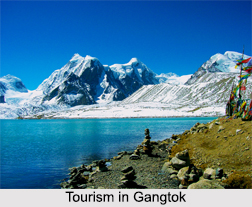 Gangtok, the capital city of Sikkim, is the seat of governance and the primary hub of commercial activity. The drive up the Teesta gorge to this prettily located first town of Sikkim is spectacular. The town is a convenient base for trips to the ethereal environs of the mystical Tsomgo Lake and Nathu La. Flower-filled meadows and hot springs, splendid vistas and tribal culture lure travellers to Sikkim. The misty, fairytale-like village of Pelling, the great tourist attraction, has sensational views of Mt. Kanchenjunga. Close by is the sacred, prayer-flag encircled Khecheopalri Lake (wish fulfilling lake). Tourism in Gangtok takes every visitor in awe of its tremendous natural beauty peppered with lofty Himalayan peaks, serene alpine lakes, entrancing waterfalls and vibrant Buddhist monasteries.
Gangtok, the capital city of Sikkim, is the seat of governance and the primary hub of commercial activity. The drive up the Teesta gorge to this prettily located first town of Sikkim is spectacular. The town is a convenient base for trips to the ethereal environs of the mystical Tsomgo Lake and Nathu La. Flower-filled meadows and hot springs, splendid vistas and tribal culture lure travellers to Sikkim. The misty, fairytale-like village of Pelling, the great tourist attraction, has sensational views of Mt. Kanchenjunga. Close by is the sacred, prayer-flag encircled Khecheopalri Lake (wish fulfilling lake). Tourism in Gangtok takes every visitor in awe of its tremendous natural beauty peppered with lofty Himalayan peaks, serene alpine lakes, entrancing waterfalls and vibrant Buddhist monasteries.
Location of Gangtok
Perched at a height of 5500ft, Gangtok – "top of hill" – lures visitors with its fabulous views of magnificent Mt. Kanchenjunga. Its strategic location, a strong Buddhist presence and heady cultural offerings are a tempting insight into this stimulating land.
Tourist Attractions in Gangtok
There are many places to visit around Gangtok. Some of them are:
Nathu La Pass: Being one of the highest altitude passes located on the Indo-China border, it is around 56 kms from Gangtok. Nathula pass forms the connecting link between Sikkim and Tibet. This pass is considered as one of the highest motorable roads.
Tsomgo Lake: This is a glacial lake also called as "Changu Lake". It is 40 kms from Gangtok. The lake remains completely frozen during winter months. The lake along with the ice covered mountains and the surrounding alpine forests make for marvellous views.
Rumtek Monastery: Also called as the Dharma chakra centre, it is one of the largest monasteries in Sikkim. It is located 24 kms away from Gangtok. Here 1001 golden Buddha statues were installed; many Buddhist paintings and murals are also seen here.
 Ganesh Tok View Point: Ganesh Tok is a small temple dedicated to Lord Ganesh. Located at an altitude of 6,500 meters above sea level, this place is the view point for some of the most breathtaking panoramic views of the town below.
Ganesh Tok View Point: Ganesh Tok is a small temple dedicated to Lord Ganesh. Located at an altitude of 6,500 meters above sea level, this place is the view point for some of the most breathtaking panoramic views of the town below.
Kanchenjunga Biosphere Reserve: This reserve is 45.9 kms from Gangtok. This park has 18 glaciers, 19 mountains and 17 high altitude lakes. Rare animals and birds like Snow Leopard, Red panda, Musk deer, Grey peacock pheasant, Himalayan snowcock, etc. can be seen here.
Hanuman Tok: Located on the upper reaches of Gangtok, Hanuman Tok is a temple complex dedicated to Lord Hanuman. This temple, built at the site is considered as the spot where Lord Hanuman rested while carrying the mountain with the “Sanjeevani†herb.
Deorali Orchid Sanctuary: More than 200 species of magnificent orchids are grown here. April to June is the best time to visit this park as the orchids are in full bloom. Besides preserving the diversity of orchid species, this sanctuary is also an ecological hotspot.
Namgyal Institute of Tibetology: This institute is world famous for its research in areas of Tibet culture and language. A museum and a library are located in the campus. It has over 200 Buddhist icons and other prized objects of art.
Tashi View Point: Tashi View Point in Gangtok is a circular viewing point. The spot provides a brilliant panoramic view of the Kanchenjunga Peak on a clear day. It was built by Tashi Namgyal who was the king of Sikkim (1914-1963).
Visiting Information for Tourism in Gangtok
The nearest airport is located in Bagdogra Airport (124 km) and the railway station at New Jalpaiguri (148 km). Roadways in Gangtok are well connected to all major cities in India.



















